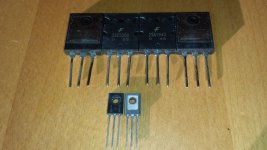Hi,
about one year ago I bought some pairs of 2SA1943/2SC5200 and a bunch of BD159's as well. They're labelled as being made by Fairchild and Motorola, respectively.
Yes, in ignorance of the existance of fakes I bought them via ebay. Meanwhile I've learned that most probably any device offered on ebay has to be suspected as being counterfeit. But could anyone, please, tell exactly what I've got? I'd only like to know for sure. Thanks in advance!
Best regards!
about one year ago I bought some pairs of 2SA1943/2SC5200 and a bunch of BD159's as well. They're labelled as being made by Fairchild and Motorola, respectively.
Yes, in ignorance of the existance of fakes I bought them via ebay. Meanwhile I've learned that most probably any device offered on ebay has to be suspected as being counterfeit. But could anyone, please, tell exactly what I've got? I'd only like to know for sure. Thanks in advance!
Best regards!
Attachments
Hi,
about one year ago I bought some pairs of 2SA1943/2SC5200 and a bunch of BD159's as well. They're labelled as being made by Fairchild and Motorola, respectively.
Yes, in ignorance of the existance of fakes I bought them via ebay. Meanwhile I've learned that most probably any device offered on ebay has to be suspected as being counterfeit. But could anyone, please, tell exactly what I've got? I'd only like to know for sure. Thanks in advance!
According to the Fairchild datasheet they use a different shape of the lead out and they have a plastic 'sleeve'. Also, the logo is different, the top line ends with the vertical (or more slender) one.
Though, both could be changed without notification and the F transistors could be (very) old stock. I can't tell for sure but I would rather suspect them to be fake.
Thanks a lot for this info - though being a not too optimistic one 🙄.
I always prefer going for sure over being discouraged, as I'd wish to use these devices in my upcoming Honey Badger project. So, are there any reliable tests, or measurements, that I could perform?
Best regards!
I always prefer going for sure over being discouraged, as I'd wish to use these devices in my upcoming Honey Badger project. So, are there any reliable tests, or measurements, that I could perform?
Best regards!
Hi,
about one year ago I bought some pairs of 2SA1943/2SC5200 and a bunch of BD159's as well. They're labelled as being made by Fairchild and Motorola, respectively.
Yes, in ignorance of the existance of fakes I bought them via ebay. Meanwhile I've learned that most probably any device offered on ebay has to be suspected as being counterfeit. But could anyone, please, tell exactly what I've got? I'd only like to know for sure. Thanks in advance!
Best regards!
Hello!!!2SA1943/2SC5200 are fake for sure but they still will work just put them a lower voltage and go until you get orginals.
By the way ....When Germans buying fake and copy parts from Chinese you know That the end of the World is near!!!(only joking) 😀
Last edited:
For every bloke in China who orders a Maybach, there are half a dozen folks in Germany who bought a Geely 300.
Nothing new or spectacular, merely market demand.
Nothing new or spectacular, merely market demand.
As I recall, the seller of my trannies wasn't located in China. At least the package came from a domestic adress. That's why I'm not inclined just to follow any statements, but to know for sure.
Best regards!
Best regards!
Fake 2SJ162s:
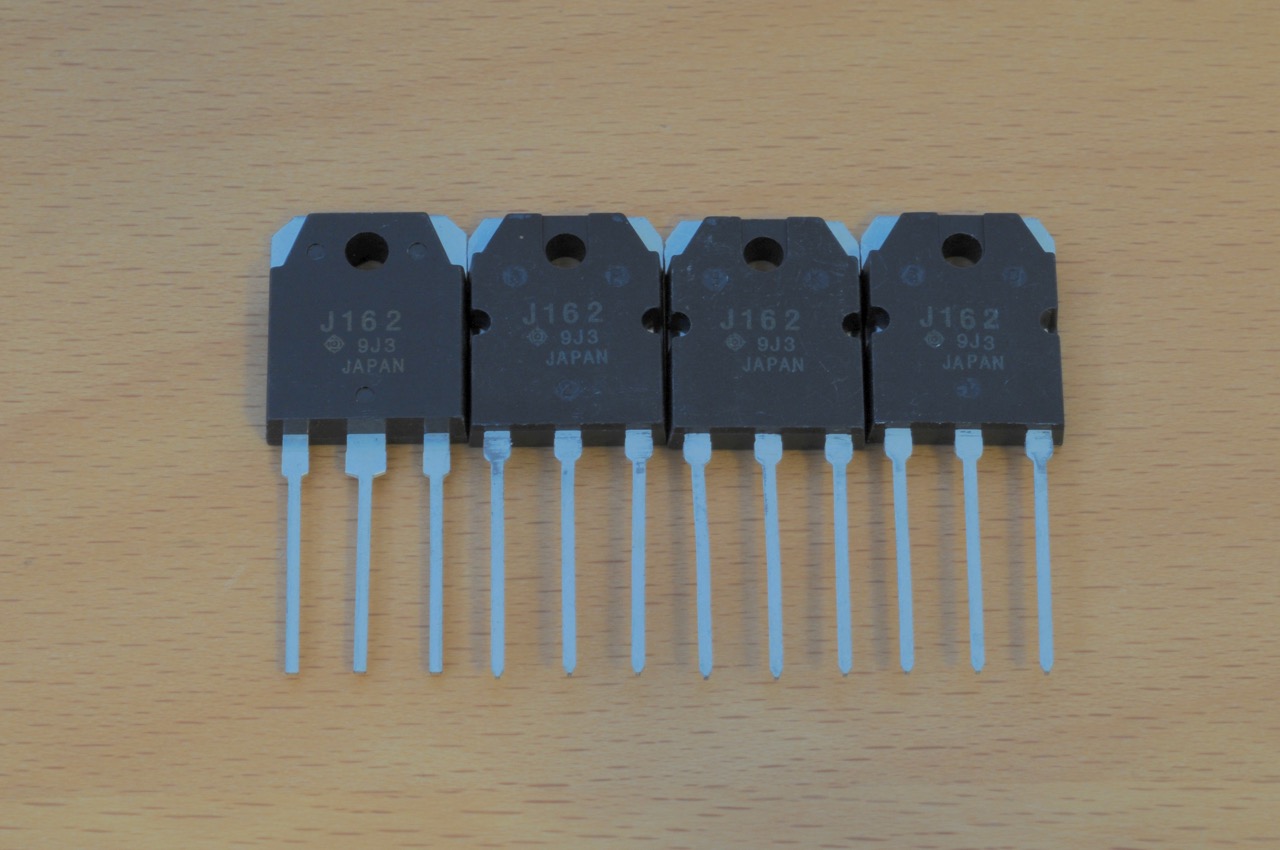
And fake 2SK1058s:
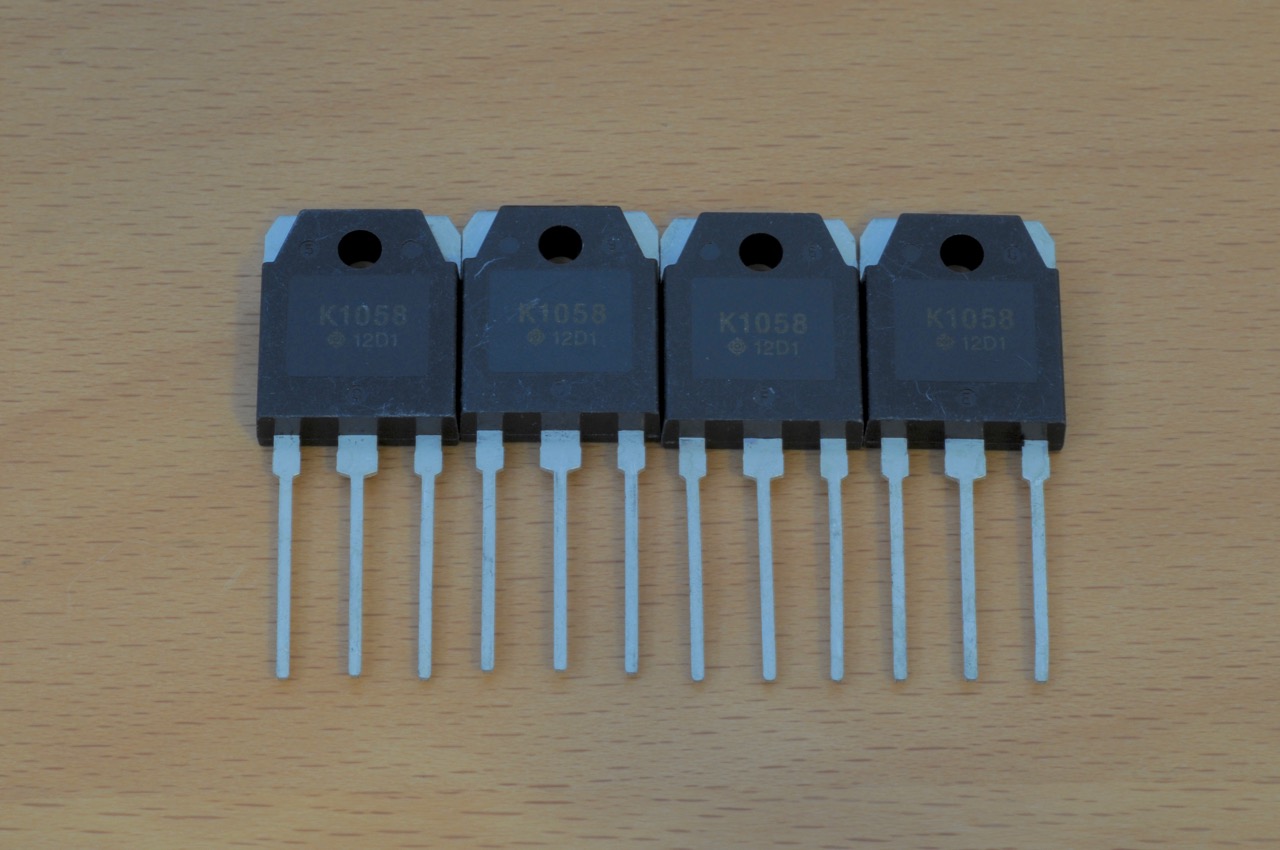
Having known-good ones for comparison is useful. Here's real parts:
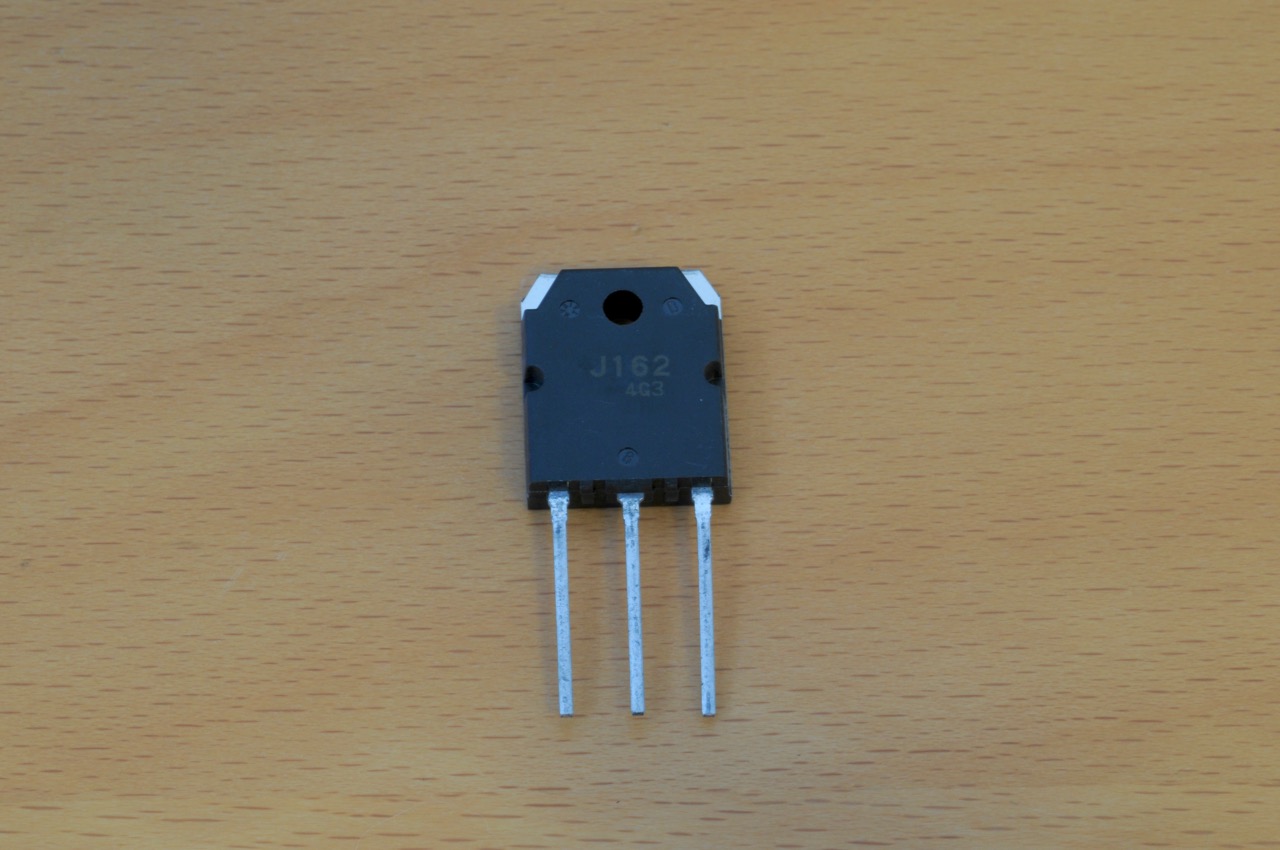

Cgs on the real ones is 840pF for my 2SK1058s, and 1.19nF for my 2SJ162s. Cgd is 640pF for the 2SK1058 and 1.20nF for the 2SJ162s.
The counterfeits with larger tabs on the leads all measured ~4nF Cgd. The other three overflowed my meter (Fluke 87).
Annoyingly, these were form a US seller with a reasonably good reputation, via ebay, and I paid a premium.

And fake 2SK1058s:

Having known-good ones for comparison is useful. Here's real parts:


Cgs on the real ones is 840pF for my 2SK1058s, and 1.19nF for my 2SJ162s. Cgd is 640pF for the 2SK1058 and 1.20nF for the 2SJ162s.
The counterfeits with larger tabs on the leads all measured ~4nF Cgd. The other three overflowed my meter (Fluke 87).
Annoyingly, these were form a US seller with a reasonably good reputation, via ebay, and I paid a premium.
I'm not a silicon expert but wouldn't a fake read 'less' capacitance due to a smaller wafer ? Did you try to use them in any case ?
Maybe you should also break them open to see the size of the wafer. Real estate of the wafer is critical. Cheap copies would only have smaller wafers I think. If so the capacitance would probably be lower unless I'm missing something.
Of course other parameters might be off too !
Try building a jig and testing them in a real circuit. Maybe you can still use them ?
If you see the pictures on the forum of other power devices , they invariably have much smaller chips in them. That could only mean lower capacitance between junctions ! This one is interesting. Let us know what you find after testing them. Check the transconductance at different points.
I have slightly different looking ones too. I need to check them. Notice your 'good' ones have no Hitachi or Renesas stamps on them ! I have some of those too.
Maybe you should also break them open to see the size of the wafer. Real estate of the wafer is critical. Cheap copies would only have smaller wafers I think. If so the capacitance would probably be lower unless I'm missing something.
Of course other parameters might be off too !
Try building a jig and testing them in a real circuit. Maybe you can still use them ?
If you see the pictures on the forum of other power devices , they invariably have much smaller chips in them. That could only mean lower capacitance between junctions ! This one is interesting. Let us know what you find after testing them. Check the transconductance at different points.
I have slightly different looking ones too. I need to check them. Notice your 'good' ones have no Hitachi or Renesas stamps on them ! I have some of those too.
More likely the die is a regular vertical mosfet, when the original is a lateral with ~1V Vgson.
Measuring the turn on voltage will tell you which you have
Measuring the turn on voltage will tell you which you have
I'm not a silicon expert but wouldn't a fake read 'less' capacitance due to a smaller wafer ? Did you try to use them in any case ?
Maybe you should also break them open to see the size of the wafer. Real estate of the wafer is critical. Cheap copies would only have smaller wafers I think. If so the capacitance would probably be lower unless I'm missing something.
Of course other parameters might be off too !
Try building a jig and testing them in a real circuit. Maybe you can still use them ?
If you see the pictures on the forum of other power devices , they invariably have much smaller chips in them. That could only mean lower capacitance between junctions ! This one is interesting. Let us know what you find after testing them. Check the transconductance at different points.
I have slightly different looking ones too. I need to check them. Notice your 'good' ones have no Hitachi or Renesas stamps on them ! I have some of those too.
These are supposed to be lateral mosfets. They differ from their much more common vertical mosfet counterparts in their low capacitance and high speed. More capacitance = slower part. Assuming the fake is a rebadged vertical fet, it's also prone to thermal runaway when used as a substitute for a lateral part in an amplifier which has no Vbe multiplier to keep bias sensible.
I've taken some better photos. In each case the fakes are on the left and the known good ones (they come out of the same tube as transistors that I've got in amplifiers that have been tested to death) are on the right:
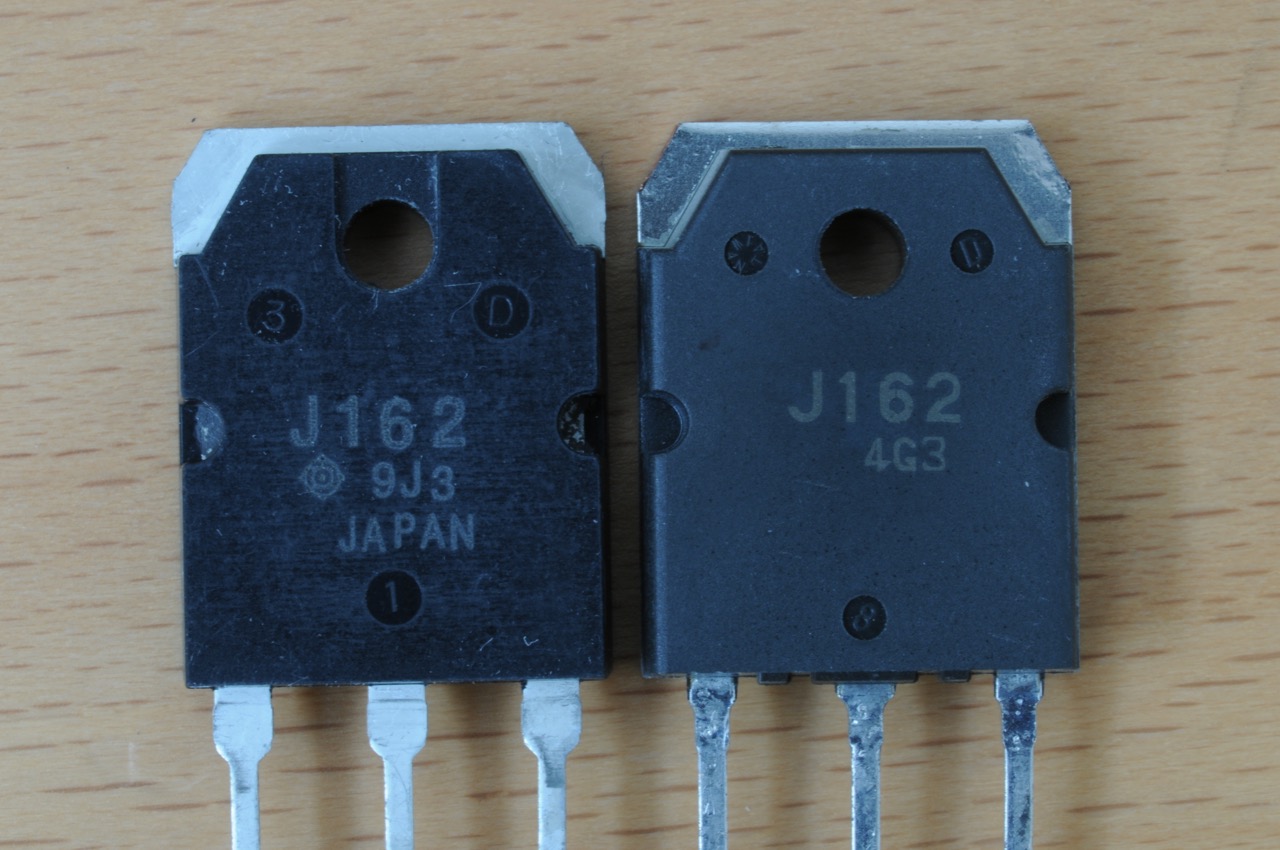
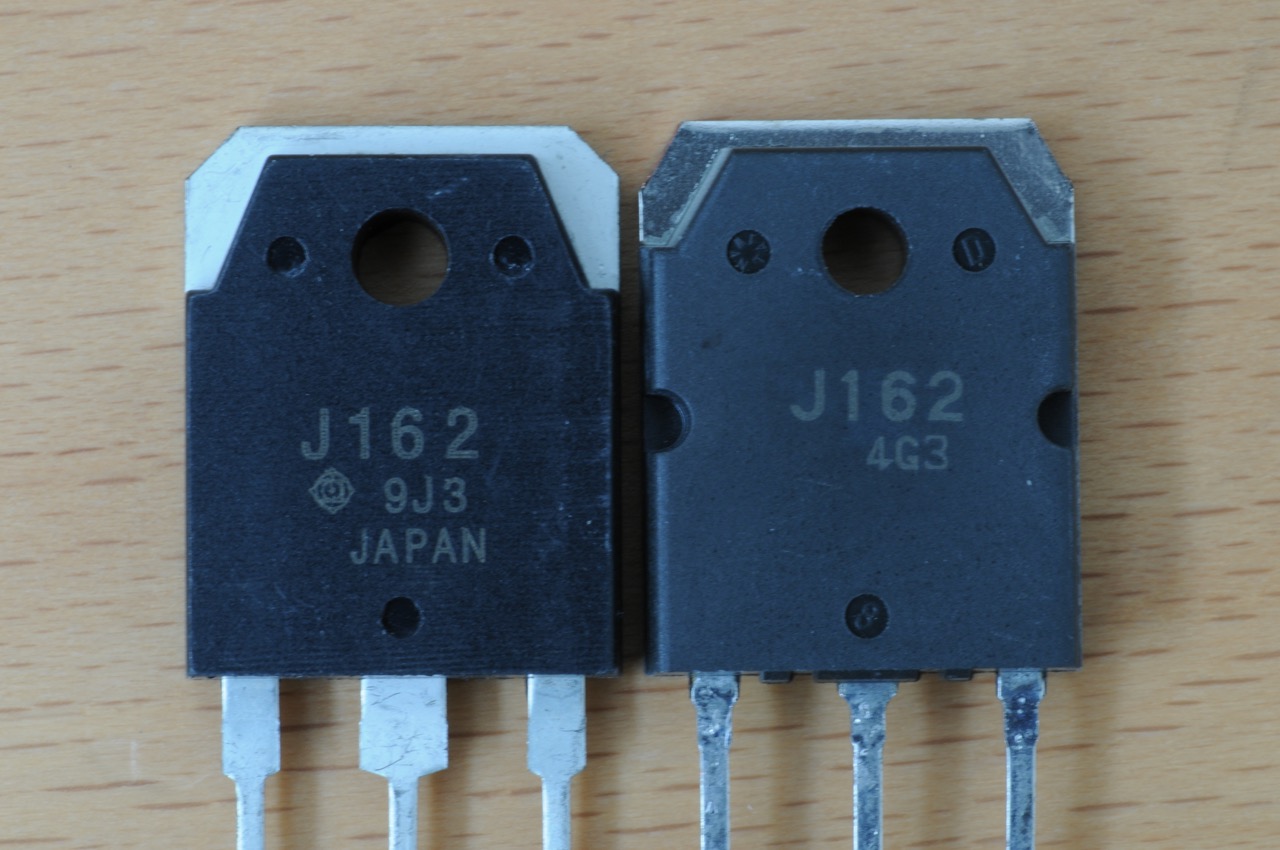
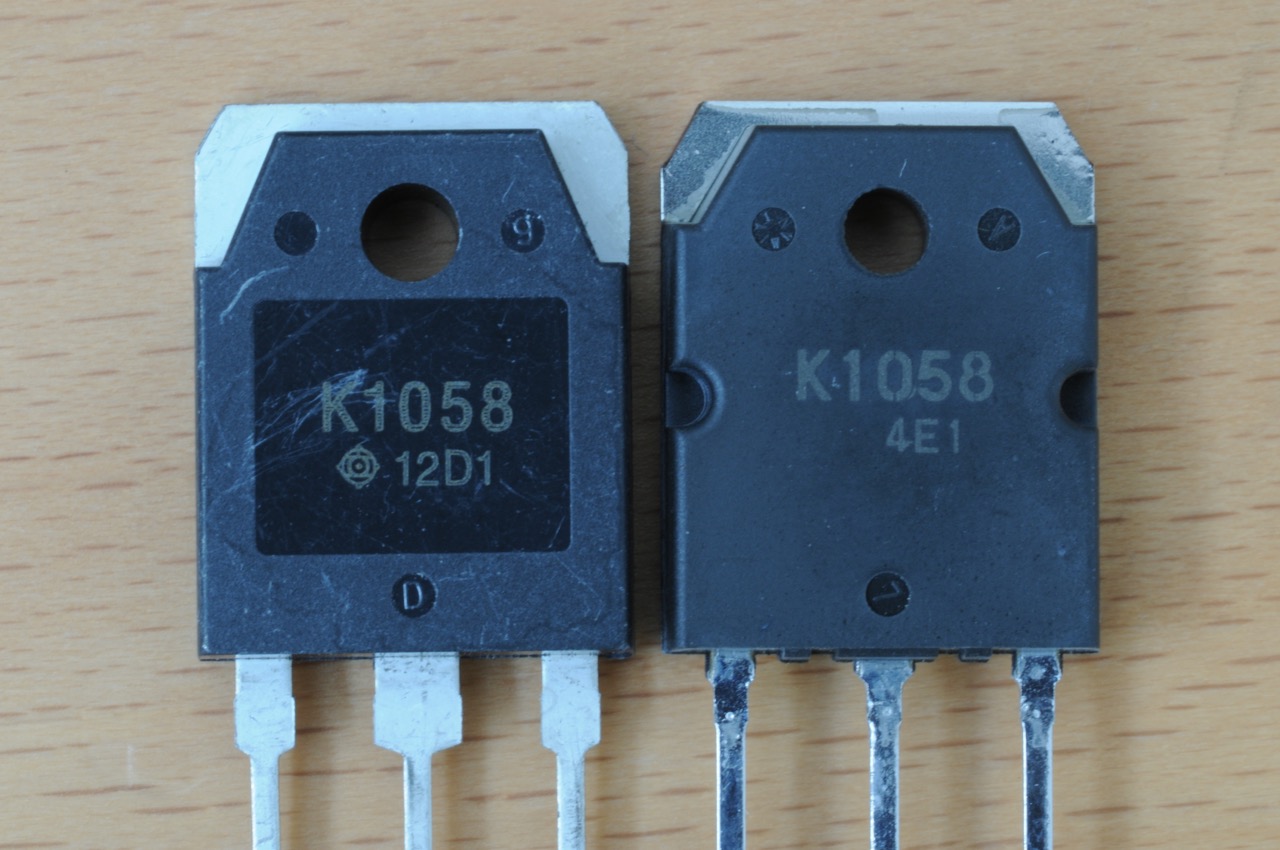
In each case marking is done with a laser, which is a recent thing, unlike Hitachi becoming Renesas. So you'd think a genuine Hitachi part would have older tech to mark it than a Renesas part.
Here's a good photo, showing what happens when I scrub a "2SJ162" with isopropyl:

Note the black goop, and also note the raster pattern is more obvious, extending across the surface of the transistor. I wonder if they use a laser to obliterate the old part number, then coat the transistor with black paint, then remark with the laser.
I'm not putting them in amplifiers. They're going in the bin.
Last edited:
Suzy, did you check your fake laterals for proper pinout - GSD (for laterals) vs. GDS (for verticals). Maybe you got yourself a bunch of usable vertical MOSFETs....
I also checked my genuine Hitachi 2SJ162 and 2 SK1058 and found out, that all the physical characteristics (cut-outs and markers on the case) are identical to the renesas types on the right side of suzyj pictures, but the marking of the case is identical to those of the 'fake' sj162. With my low-cost transistortester Mega328 from China i tested the devices and it shows for example for a 2sk1058 a Cgs value of 570pf and a threshold voltage Ut of 0,45V. Since i own them more than 15 yrs, i think they are genuine.
If suzyj's devices are really fakes, why didn't you name the US supplier you buy it from. Maybe it's against the forum rules. 🙁
If suzyj's devices are really fakes, why didn't you name the US supplier you buy it from. Maybe it's against the forum rules. 🙁
Hi suzyj,
I also contacted vendors where counterfeit parts were bought and they refunded the money with one demanding that I cut the legs off the counterfeit parts. Reasonable since they were to be discarded and no one wants them to end up back in the system again. I usually use a mallet and anvil to permanently mark the fakes before I discard them. No matter how you do it, the non-genuine parts must not be allowed to be used by anyone.
Have you made contact with the vendor in this case?
-Chris
I also contacted vendors where counterfeit parts were bought and they refunded the money with one demanding that I cut the legs off the counterfeit parts. Reasonable since they were to be discarded and no one wants them to end up back in the system again. I usually use a mallet and anvil to permanently mark the fakes before I discard them. No matter how you do it, the non-genuine parts must not be allowed to be used by anyone.
Have you made contact with the vendor in this case?
-Chris
Suzy, did you check your fake laterals for proper pinout - GSD (for laterals) vs. GDS (for verticals).
How does one do that?
Best regards!
By wiring it in a simple circuit and observing how the part behaves or, easier, with a little help ofHow does one do that?
Best regards!
https://www.elv.at/peak-atlas-dca-75-halbleiter-tester.html
Tomorrow I'll check my parts bought pre 2000 and after 2004. I have no Renesas parts. The ones bought after 2004 were like your 'good ' part. No brand name on it or any logo. The much older ones ( around 1996 I think ) had the Hitachi logo on them. They might be even older.
Easiest I think is to check the Vgs for it to turn on.The Latfets are around 1 V and around 3.6 V for the Verticals. But the pin orientation is also a give away ! It might still be a useful device if it's a Vfet. You can also check the breakdown voltage ( Vds). Don't bin it till you are sure that its of no use for 'anything' !
Easiest I think is to check the Vgs for it to turn on.The Latfets are around 1 V and around 3.6 V for the Verticals. But the pin orientation is also a give away ! It might still be a useful device if it's a Vfet. You can also check the breakdown voltage ( Vds). Don't bin it till you are sure that its of no use for 'anything' !
i can see the three pips/islands where the pins exit the package.These are supposed to be lateral mosfets. They differ from their much more common vertical mosfet counterparts in their low capacitance and high speed. More capacitance = slower part. Assuming the fake is a rebadged vertical fet, it's also prone to thermal runaway when used as a substitute for a lateral part in an amplifier which has no Vbe multiplier to keep bias sensible.
I've taken some better photos. In each case the fakes are on the left and the known good ones (they come out of the same tube as transistors that I've got in amplifiers that have been tested to death) are on the right:



In each case marking is done with a laser, which is a recent thing, unlike Hitachi becoming Renesas. So you'd think a genuine Hitachi part would have older tech to mark it than a Renesas part.
Here's a good photo, showing what happens when I scrub a "2SJ162" with isopropyl:

Note the black goop, and also note the raster pattern is more obvious, extending across the surface of the transistor. I wonder if they use a laser to obliterate the old part number, then coat the transistor with black paint, then remark with the laser.
I'm not putting them in amplifiers. They're going in the bin.
My genuine are the same as those on the right. They show on your pic.
Do any of your's have a detent on the back face?
Do any have the "break off" on the top edge?
- Home
- Design & Build
- Parts
- My Transistors, original or copy?
